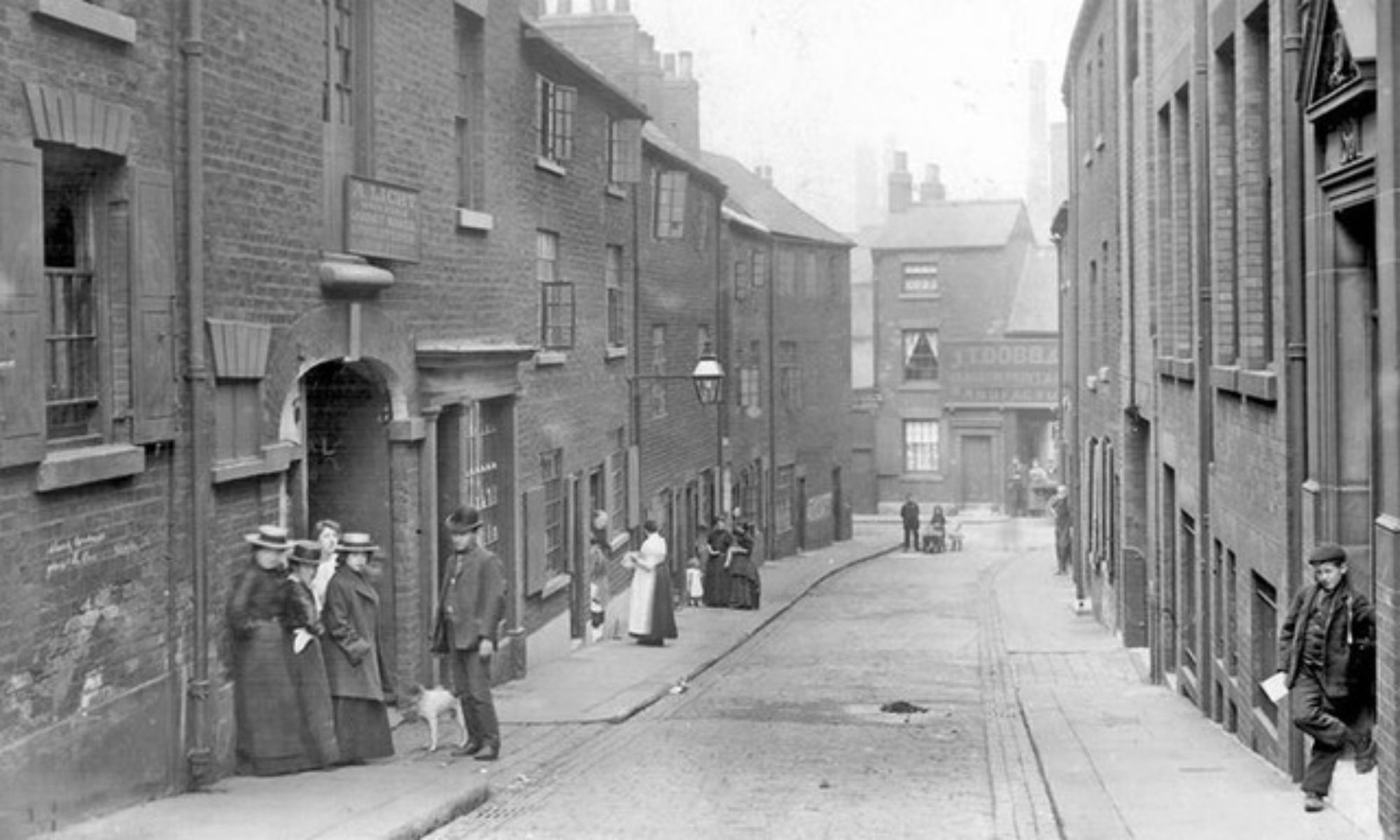On May 27, 1944, a Halifax Bomber, HX 313, was ripped and torn by a German night Fighter after dropping its bomb load on Bourg Leopold, Belgium.
A cousin who I had never met was the upper Middle Gunner and was killed as the night fighter shells ripped across the underbelly of the plane. Over the last few decades I have been able to reconstruct much of what happened before, during and after that fateful evening. My use of dialogue may offend sensitive ears. Sorry about that. This will be a long story…to be sent in segments.
alan skeoch
Nov. 2017
(from manuscript written in 1980-1990)
“Night Fighter coming fast…under our guts.”
“Can’t see him Vic…”
“Stitching us…fucking bastard…can anyone hear me?”
“We’re hit bad, Vic…trying toehold her steady…think we’re going in.”
“George…George…for Christ sake answer, George.”
“Crew check, pipe down Victor…
”Bob…bob…take a look behind me…Bob OK?”
“Dead, Eric…slumped…blood.”
“Victor? …Am Ok but hydraulics hit.:’”
:Wild…Wilf?…someone check on Wilf…”
“Ken…Ok…think Wolf got it, maybe George too.”
“Morris…Morris?…Someone check on Morris…controls shaky…”
“Elliot, you all rigjht?”
“OK! Fuck, we’re going down. Eric can you hold her?”
“Get the hell out…now…Jesus Christ she’s shaking.”
“Victor?”
“Fucking bubble won’t turn…hydraulic lines cut…can’t get out of this fucking thing.”
“Rest of you, jump now…’chutes on I goddamn well hope.”
“Victor…Victor…try to manually twist the goddamn bubble…”
“Won’t fucking move. “
“Someone get back there and get that fucking bubble to swivel…”
“Ken here…fucking thing is fucked…Victor, can’t help you…goddamit”
‘Get the hell out yourself Ken…I’m going down with her…”
“Everybody out that can get out…can’t hold her any longer….going into flat spin…”
“All out…so long Victor. Sorry…keep trying…”
“Jesus, I’m done for…witness to my own death. Hope George got out. Never heard from him.
Ken was evasive.”
….
“Starting to turn…centrifugal force..”
…
“Fucking bubble moving outward…outward…I can fall out…”
…
“Falling…free…”
…
“Goddamn ‘chute not attached right… just the buckler belt…Falling…got to pull ‘chute down…reach it … shove
myself in…now. can just pull the rip …ready? PULL HARD.
…
FWOOM!
…
“She’s opening. …
…
“YOW…hurts like hell…my Groin…my balls…jesus!”
…
“Old Blonde Bomber pirouetting…going to hit…FLASH!…She’s gone…hope boys got out.”
…
“George didn’t answer roll call…maybe his intercom fucking smashed. Maybe not!”
…
“See a field…coming up fast…YOW! …hurts like hell…but on the fucking ground.”
…
“Dark…must hide ‘chute…pain bad…crawl to fencerow…hide….God…the pain.”
…
“Got to give myself up…crawl to that farmhouse…”
…
“Here, take this evader money…call police to come and get me…Pain bad.:
(Note: Crew of HX 313. Eric Mallett, pilot; Bob Irwin, wireless operator, killed; Wilf Wakely (killed), Vic Poppa, Tail Gunner;
Ken Sweatman, Bomb Aimer; Morris Muir (English engineer); George Freeman, mid-Upper Gunner, killed; Flying Officer Elliot (assigned to HX 313 to
make him familiar with bombing raids, his first trip)
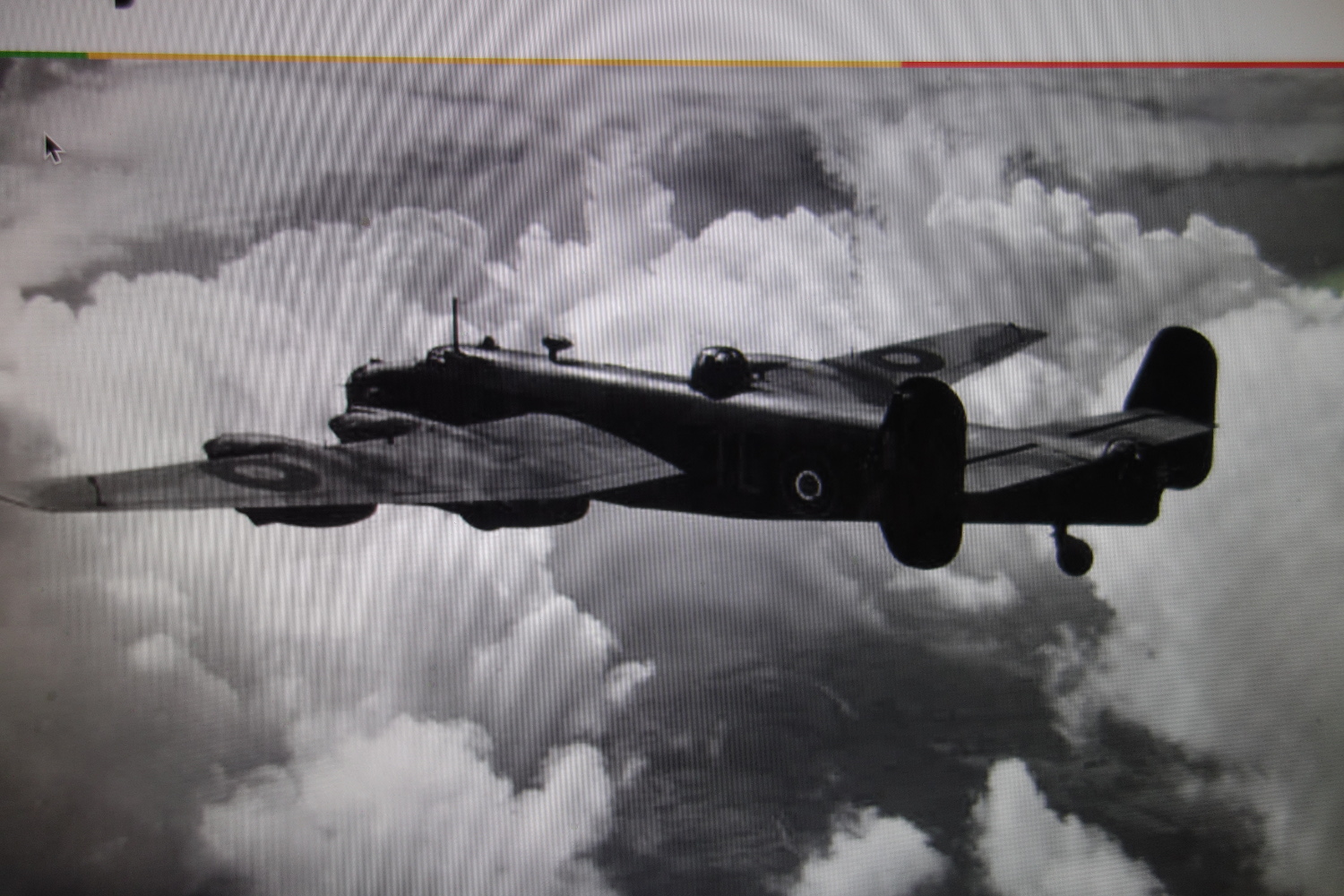
Halifax bomber identical to HX 313…only thing distinguishing HX 313 from others was a nose art painting of a semi-clothed woman beneath which was
painted “The Blonde Bomber”. Just one of the 12,000 planes, mostly bombers, shot down in World War 2.
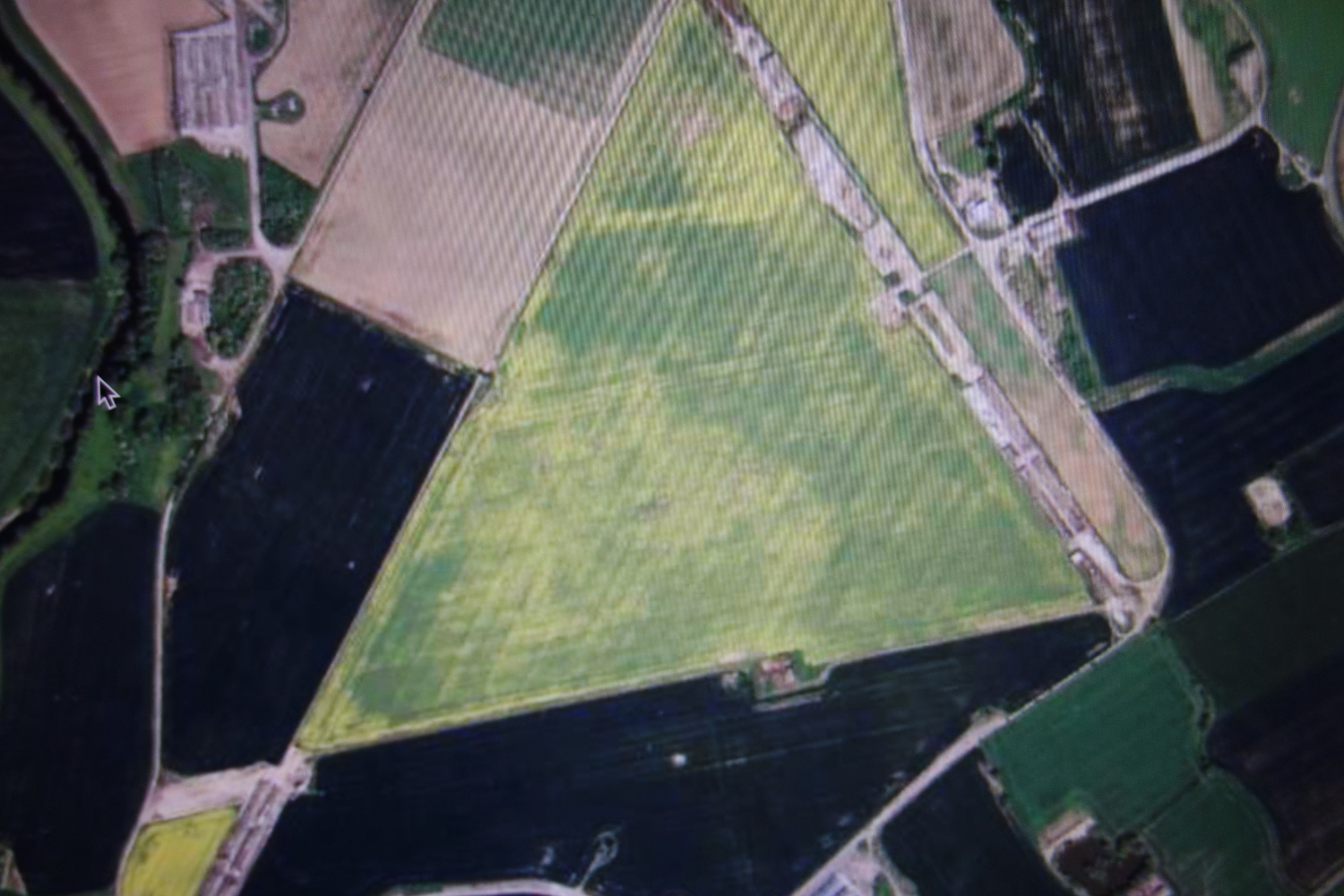
The Skipton on Swale air base as it appears today. When we visited the site years ago it had been converted to a large poultry operation. the ruways had been ripped up except for some heavy concrete set down pads.
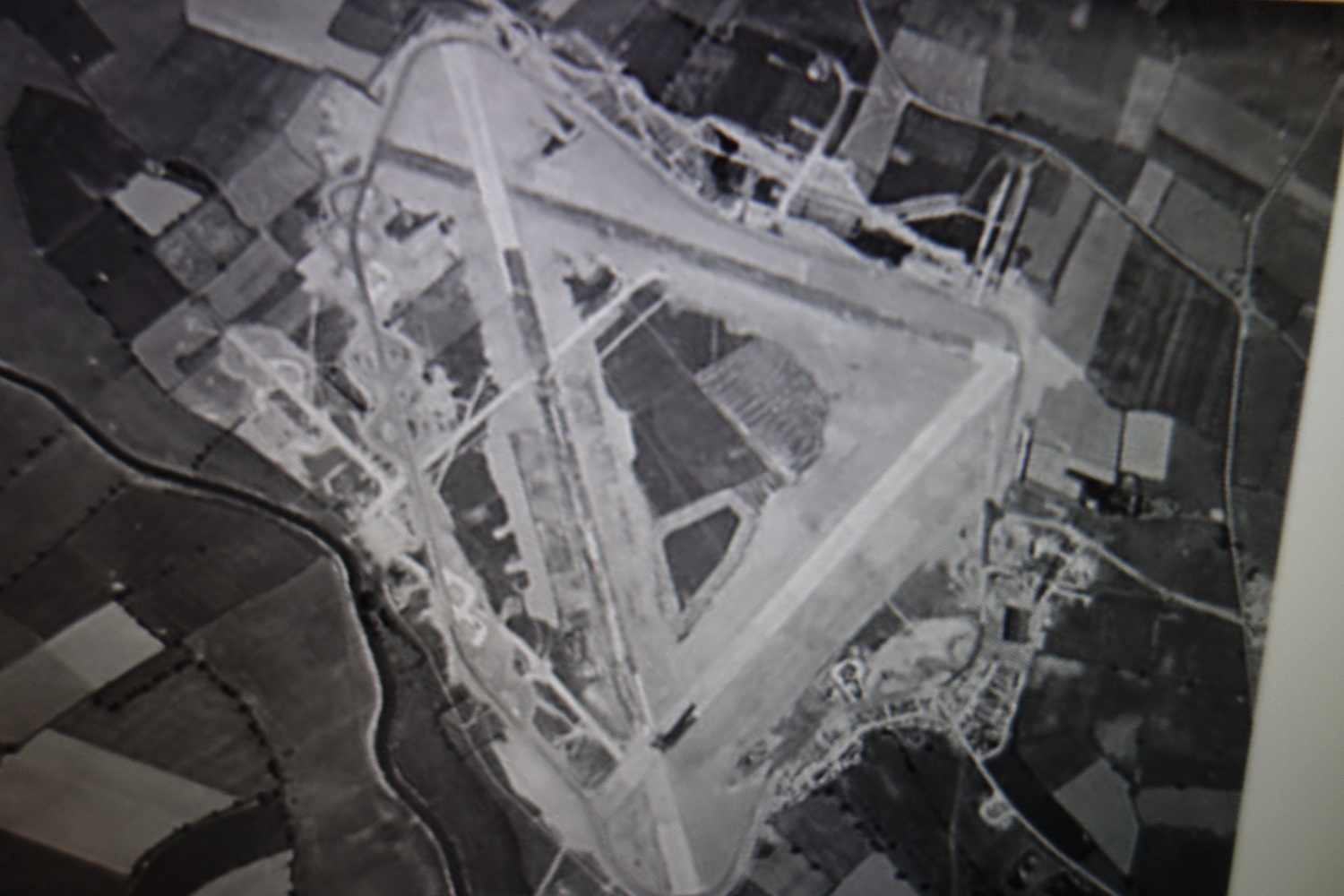
This is what Skipton on Swale looked like in 1944…a triangle of runways and holding pads.
“Alan, we don’t have much…just a few fragments…mom and dad only got this and a few others.”
“Thanks, Mickey, I know this story could be rough on you.”
“Mom and dad are gone now…I would sort of like to know what really happened to George.”
And so the story began…fragments became clues…clues unfolded the story of The Last Flight of HX 313…the Blonde Bomber.
One piece seemed Just a nonsense photograph. Almost a throwaway. An RCAF officer’s hat sitting upside down n front of a military quintet hut with a little dog sitting in the hat and scrawled below was the picture was the word ‘Nooky’, obviously the puppies name.
Sometimes very simple things lead to very big events. Such was the case of that photograph. It was taken in 1943 or 1944 by George Freeman at a newly constructed
air base at Skipton on Swale in central Yorkshire. That much I knew. One of the few reminders to me that George was once a living breathing young man. Never met
George even though he was my cousin. When he volunteered as a gunner in World War II, I was just a little boy perhaps four or five years old. At that age the world is huge, anonymous and a bit frightening. Puzzling out relatives impossible. If George met me, as he may well have done, he might have tickled me under the chin
or frizzed up my hair with his hand.
“Here Alan are a couple of pictures of George. RCAF pictures. Not supposed to take many pictures. Security. Once they were joyful but tragic events changed all that.”
“Who was George?”
Who was George indeed! Forty years ago, maybe around 1975 I Was doing short stories on CBC’s Radio Noon. Little five minute things. That was why my cousin Mickey
gave me George’s picture. “Might be something you could use for Remembrance day on the radio.” Could I uncover the short life of a cousin I had never met?
The officers cap with the puppy and the word ‘Nooky” was as good a place as any to start. “What does the word mean?” If I had known the meaning of the word
I would never have made it the central mystery of my radio story. Over the air waves I wondered if anyone could tell me anything about the lives of the young men aboard HX 313 when it was shot down in May 1944. “perhaps this word Nooky is a clue”
The response was immediate. Particularly I discovered that Nooky referred to sexual activity. Something young airmen sought after frantically because, by 1944, most of them were aware their lives were going to come to an abrupt end. Too many of their friends had died for them not to know the odds were stacked against them as they made raid after raid deep into central Germany in Halifax and Lancaster bombers. Slow lumbering machines targeted by swift German night fighters. So it was sex that started me
on the trail of George. This is the story which I have titled ‘The Last Flight of HX 313”.
Death doesn’t impact on a five year old as much sit does on an older person. When George Freeman was declared missing on Mya 27, 1944, I barely noticed.
My parents were a little different that day,..distracted…so my brother and I just sipped out to Dufferin Park a little earlier than usual. We didn’t really know there was a war being fought in Europe, the Soviet Union, the Middle East, Burma, China and ten-aged hoodlums attacked each other with lead pipes, baseball bats, knives and, when the weaponry was limited, their bare fists and feet. Etc and I scouted the battlefield from our third floor attic like turkey vultures seeking carrion. Our rented
flat at 18 Sylvan Avenue was dark and scary, a Victorian mansion at one time but subdivided by our landlady into apartments. After the gangs ceased fighting due
to police counter raids, Eric and I tried to gather the hidden tools of war and trundled them home. Some things we found were more related to love than war as it turned out. Mom told us not to bring any more of those Perfectly good used balloons
found beneath the forsythia bushes. “Dirty things, boys,”
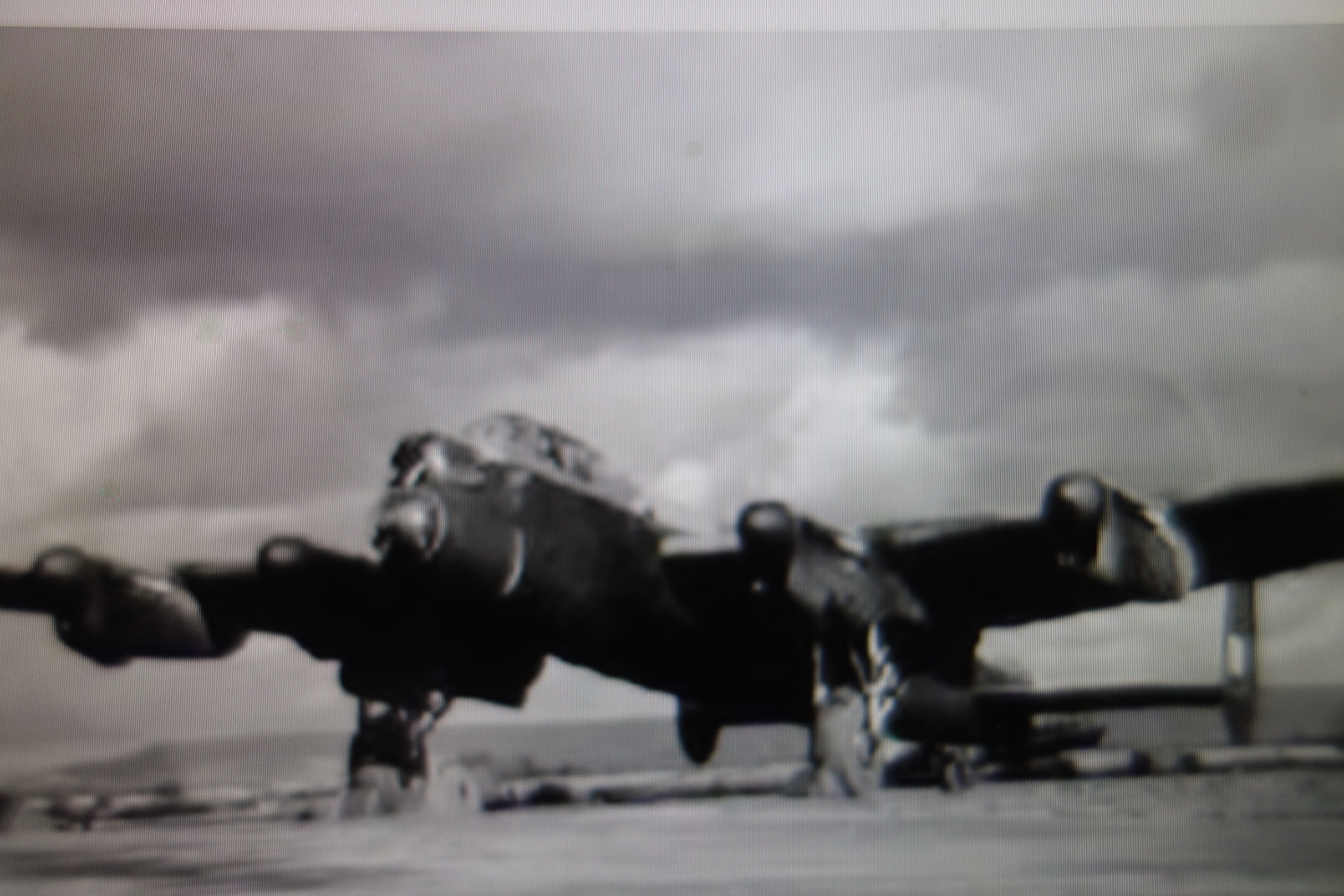
“Red, the letter came today saying Missing in Action.”
“Who this tlme?”
“George Freeman, the kid.”
“They are all kids, Elsie,…How are Uncle Chris and Aunt Kitty taking it?”
“Bad but hope for the best”
“Those Air Force boys are getting the shit knocked out of them.Especially the bomber crews…Flying coffins.”
“What do you think his chances of survival are?”
“Not good but some survive. We know that from the Red Cross parcels that get to German Stalags.”
It was a whispered conversation, not meant for our ears. Eric was four and I was six in 1944.. So young that we did
not even know there was a war going on in Europe, Russia, the Middle East, China, Japan, the island strings
in the Pacific Ocean, To Eric and I any mention of war must mean Dufferin Park where the Beanery and Junction
gangs squared of regularly. Now that was a war.
“Eric, come quick the Junction gang has arrived. There’s going to be a big fight for sure.”
“Guns?”
“don’t see any…pieces of pipe and baseball bats.”
“Look a Beanery guy just slugged a kid with a piece of pipe…kid dropped down.”
“Dead?”
“No…moving … crawling”
“Police are there now…got one guy on the hood of the police car…punching him.”
“Watch where they hide their weapons…we can get them with the wagon.”
“Leave those balloons…don’t pick them up…Mom says they are dirty old things.”
“Make good balloons though.”
Our rented flat at 18 SylvanAvenue, was a huge old Victorian pile of bricks that sat smack dab in
the south central core of the park. Gone now. Demolished when Dufferin Park was expanded. The reasons why these two gangs of
teen-agers fought made no sense to us. Made no sense to mom and dad either.They fought over girls. They fought over territory. I
think they just liked to fight. A gang rumble was a kind of rite of passage.
“What happened Alan?”“The bad boys got me in the ravine…took off my clothes.”“How many times have I told you not to take that short cut through the park?”“I know mom…but they didn’t get the cucumber.”“Cucumber?”“Put it in my shoe…hid it…here it is.”“Where did you get that?”“Teacher gave one to all of us.”“Why put it in your shoe?”“Because the bad boys check my pockets when they catch me.”Fear made Eric and I cautious. The acquisitive instinct made us take risks. So we spotted where the gangs hidtheir weapons as the police rounded them. In 1944, Dufferin Park had a real wilderness feel to it. Hills that seemedhigh to us and a deep totally wooded ravine cut right through the park. The slash of that ravine had to be crossed to gethome from Kent Public School. And that ravine was where the weapons could be stashed under bushes so thick that peoplecould even hide beneath them. Eric and I hid there sometimes. Other things happened in that ravine that werequite bewildering. Boys and girls on top of each other. That’s where the balloons could be found.Today, year 2017, the ravine has been levelled…bushes gone. Hiding places gone. Just a slight dip in the grassy park.It was different in 1944 when the Parkie, Mr. Hayward, tended all his plantings from his little brick garden shed near Gladstone Avenue.Mr. Hayward was one of our heroes. He kept an eye on us when trouble was brewing. Our small adventures were JUST CHILD’S PLAY.
Our cousin George was in the fight of his life, a fight he would lose on May 24,1944.
BOMBER COMMAND WAS NOT CHILD’S PLAY
George Freeman was killed in May 1944….the last flight of HX313, a Halifax bomber assigned to 424 squadron of No. 6 Bomber Command stationed in Skipton on Swale, Yorkshire. The target that night was Bourg Leopold where it was believed a German regiment was billeted. The story of HX 313 is forgotten. Who among us even know the difference between a Halifax bomber and a Lancaster? Few Canadians living today know that many Canadians lived and died in Halifax Bombers.
When word came back to aunt Kitty and Uncle Chris that George was Missing in Action, they hope for the best…a slim hope…and feared the worst. By 1944
most Canadians knew the fearful losses of Bomber Command. They did not know the specifics. They just knew that their son or a neighbours son or the majority of a high school class were not coming back.
Today the numbers are known. For every 100 men and boys in Bomber Command, 45 were killed, 6 were grievously wounded and 8 became prisoners of war. Only 41
of those 100 airmen came back unscathed. Some of those survivors could never shake the nightmares that seemed unending. 10,000 Canadian airmen were killed.
The statistic is even more horrific for those who flew in bombers from the beginning of the war until the ned. Only one out of very ten survived.
We have a tendency to regard the slaughter of Canadians in the trenches of World War One as the worst any war could ever offer. Offer? Wrong word but let it stand.
The death rate in Bomber Command was only exceeded by the death rate in German submarines. Simps;y and starkly put the majority of the young Canadians who joined bomber Command did not survive.
George Freeman was one of these. Aunt Kitty and Uncle Chris put his kit bag in his room when it was returned to them. They left the room the same as it had always been.
Did George know these fearful statistics? Maybe not when he first signed up as and RCAF airman. But by the time his squadron, 424 Tiger Squadron of Hamilton,..by the
time George reached Skipton on Swale in Yorkshire he knew the odds were stacked against him. More Bombers were lost in one single night raid than were
lost by Fighter Command in the whole Battle of Britain. The average loss are of those flying Halifax Bombers with the RCAF was 6.05% per raid.Over 1 out of every 20 raiding Bombers did not return to base each raid.Bomber Crews were mandated to make 30 raids each…called tours of operations. Statistically that meant that only 16% of air crews reached thematic retirement figure of 30 ‘tours of operations’. Little wonder that some considered these Halifax bombers flying coffins.
How many heavy bombers in the total picture of Bomber Command were lost? 12,330 bombers were either shot down by Germans Fighters or fell apart when hit by German Flak or, like one of 424 squadrons Halifax Bombers that failed to get airborn with its load of bombs that had been chalked with greetings to Adolph Hitler.
Imagine that. 12,330 Bombers destroyed along with most of their crews.
I have researched and put together The story of George Freeman’s Halifax bomber,… affectionately emblazoned with a nose art image of a seductive woman and named the Blonde Bomber….but really known as HX 313.
How George died is not really known. He was likely killed at his gun position by German intercepte, George was the mid upper gunner, but it is also possible he was killed on the ground by irate German civilians
who suffered many civilian casualties in what became thousand bomber raids on German cities by the end of the war. A thousand bombers? Hard to believe but fact.
PUT IN DIALOGUE FORM:
“George didn’t have a chance?”
“What do you mean?”
“I mean most of the boys in RCAF Bomber Command were doomed. 10,000 of them died. For every 100 active Bomber crew, 45 were killed, 6 were horribly wounded
and 8 became prisoners of war.
“Get serious…I never heard that before.”
“Statisitcs came once the war was over…and not widely published.”
“How many died?”
“10,000”
“Mostly young kids full of piss and vinegar”
“Chances of an RCAF kid who volunteered at the beginning of the war and living to the end was 10%..1 in 10.
“How many bombers were lost…shot down or exploded and fell apart?
“12,330 Bombers in all … no wonder wrecks are still being discovered …”
“Didn’t I read that a German town was evacuated last moth, Oct. 2017 when a blockbuster bomb was discovered unexploded, buried unnoticed for 60 years.”
“We were hated.”
“So were they. Hated Germans. That’s the nature of war…hate justifies nasty things.”
“George may have been killed by a night fighter…or killed on the ground by an iriate civilian.”
“Why would a civilian do that?”
“George may have been killed by a night fighter…or killed on the ground by an iriate civilian.”
“Why would a civilian do that?”
“A lot of the bombs hit civilian targets.”
“Accidentally?”
“No, the bomber raids were planned to destroy German Industry…to spread terror…to break German will to resist….to win the war..”
“How many civilians killed?”
“Over 300,000 and nearly 800,000 wounded by the bombing.”
“Some say 600,000 civilians killed by bombers like HX313.”
“Estimates…who really coined?”
(Note: I like the dialogue form better than narrative…going to convert my narrative.)
